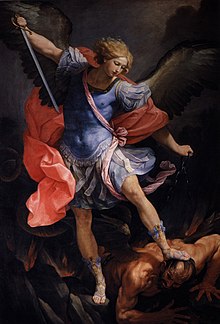
Back فن كاثوليكي Arabic Arte en la Iglesia católica Spanish Art catholique French Seni rupa Gereja Katolik ID Arte Católica Portuguese


Catholic art is art produced by or for members of the Catholic Church. This includes visual art (iconography), sculpture, decorative arts, applied arts, and architecture. In a broader sense, Catholic music and other art may be included as well. Expressions of art may or may not attempt to illustrate, supplement and portray in tangible form Catholic teaching. Catholic art has played a leading role in the history and development of Western art since at least the 4th century. The principal subject matter of Catholic art has been the life and times of Jesus Christ, along with people associated with him, including his disciples, the saints, and motifs from the Catholic Bible.
The earliest surviving artworks are the painted frescoes on the walls of the catacombs and meeting houses of the persecuted Christians of the Roman Empire. The Church in Rome was influenced by the Roman art and the religious artists of the time. The stone sarcophagi of Roman Christians exhibit the earliest surviving carved statuary of Jesus, Mary and other biblical figures. The legalisation of Christianity with the Edict of Milan (313) transformed Catholic art, which adopted richer forms such as mosaics and illuminated manuscripts. The iconoclasm controversy briefly divided the Western Church and the Eastern Church, after which artistic development progressed in separate directions. Romanesque and Gothic art flowered in the Western Church as the style of painting and statuary moved in an increasingly naturalistic direction.
The Protestant Reformation in the 16th century produced new waves of image-destruction, to which the Catholic Church responded with the dramatic, elaborate emotive Baroque and Rococo styles to emphasise beauty as a transcendental. In the 19th century the leadership in Western art moved away from the Catholic Church which, after embracing historical revivalism, was increasingly affected by the modernist movement, a movement that in its "rebellion" against nature counters the church's emphasis on nature as a good creation of God.